What'sNEW January–March 2009
 28 March 2009 28 March 2009
Bacteria rapidly acquire whole metabolic pathways by the horizontal transfer of multiple genes, and the genes necessary for a given pathway may be contributed from more than one species. These conclusions come from research by two Japanese specialists in computational biology and information systems. Using a new computer algorithm to study ancient bacterial evolution, the pair observed 379 "acquired pathways" requiring three to eight genes. Apparently, most were transferred several times.

Each sequential line from the bottom left corner to the top right represents how rapidly a pathway was acquired.... If the gradual acquisition scenario holds true, sequential lines will approach the 45° line, whereas the rapid acquisition scenario will produce lines that are strongly convex upward. |
The analysts were especially interested to know if any pathways were "novel" in the recipient species. They decide that some were. They propose, "Novel pathway evolution may be facilitated by bidirectional horizontal gene transfers in prokaryotic communities."
Evidence indicates that the transfers occurred rapidly (see figure). This could explain how pathways lacking a required gene might avoid being degraded by random mutations.
In sum, the research yielded four findings:
- "Pathways have grown beyond the random acquisition of individual genes,
- "obstacles to pathway acquisition would be overcome by the rapid acquisition of genes that would function cooperatively,
- "this rapid evolution was due to massive horizontal transfers as gene groups, and
- "the original acquisition of the pathways seems to have occurred more contemporaneously than expected across different phylogenetic clades."
The acquisition of new genetic programs among prokaryotes appears to depend entirely on horizontal gene transfer (HGT). This new research demonstrates even more about the effectiveness of bacterial gene transfer. We think horizontal gene transfer has profound implications for evolutionary theory.
 Wataru Iwasaki and Toshihisa Takagi, "Rapid Pathway Evolution Facilitated by Horizontal Gene Transfers across Prokaryotic Lineages" [open access article], doi:10.1371/journal.pgen.1000402, PLoS Genetics, 5(3): e1000402, March 2009. Wataru Iwasaki and Toshihisa Takagi, "Rapid Pathway Evolution Facilitated by Horizontal Gene Transfers across Prokaryotic Lineages" [open access article], doi:10.1371/journal.pgen.1000402, PLoS Genetics, 5(3): e1000402, March 2009.
 Viruses and Other Gene Transfer Mechanisms is the main related webpage Viruses and Other Gene Transfer Mechanisms is the main related webpage
[ What'sNEW about HGT What'sNEW about HGT  ] ]
 19 March 2009 19 March 2009
...Lateral transfer among eukaryotes and between eukaryotes and bacteria appears to be an on-going and not too infrequent process — Sandra L. Baldauf, Department of Evolution, Genomics and Systematics, University of Uppsala, Sweden.
 Sandra L. Baldauf, "An overview of the phylogeny and diversity of eukaryotes" [11-page PDF], doi:10.3724/SP.J.1002.2008.08060, p 263-273 v 46, Journal of Systematics and Evolution, 2008. Sandra L. Baldauf, "An overview of the phylogeny and diversity of eukaryotes" [11-page PDF], doi:10.3724/SP.J.1002.2008.08060, p 263-273 v 46, Journal of Systematics and Evolution, 2008.
 Viruses and Other Gene Transfer Mechanisms is the main related webpage Viruses and Other Gene Transfer Mechanisms is the main related webpage
[ What'sNEW about HGT What'sNEW about HGT  ] ]
 17 March 2009 17 March 2009
Predominantly left-handed amino acids were found in six out of six meteorites examined by a pair of astrobiologists at NASA's Goddard Space Flight Center. Some of the imbalances were so high that one remarked, "I have to admit I didn't believe it at first." With no better idea, the astrobiologists suggest that water caused the anomalous chirality — the effects of water are evident in the meteorites. But water itself has no chirality. Or maybe polarized light was responsible? But light comes equally in right- and left-handed polarity.
 On the other hand, life as we know it creates only left-handed amino acids. And when life dies out, this chirality slowly degrades away. For some amino acids, this degradation can take billions of years. Could the surprising excess of left-handed amino acids in all six meteorites have been left by ancient microbial life on their parent bodies?
On the other hand, life as we know it creates only left-handed amino acids. And when life dies out, this chirality slowly degrades away. For some amino acids, this degradation can take billions of years. Could the surprising excess of left-handed amino acids in all six meteorites have been left by ancient microbial life on their parent bodies?
 Daniel P. Glavin and Jason P. Dworkin, "Enrichment of the amino acid l-isovaline by aqueous alteration on CI and CM meteorite parent bodies" [abstract], doi:10.1073/pnas.0811618106, Proc. Natl. Acad. Sci. USA, online 16 Mar 2009. Daniel P. Glavin and Jason P. Dworkin, "Enrichment of the amino acid l-isovaline by aqueous alteration on CI and CM meteorite parent bodies" [abstract], doi:10.1073/pnas.0811618106, Proc. Natl. Acad. Sci. USA, online 16 Mar 2009.
 Southpaw Solar System, by Phil Berardelli, ScienceNOW Daily News, 16 Mar 2009. Southpaw Solar System, by Phil Berardelli, ScienceNOW Daily News, 16 Mar 2009.
 NASA Scientists Find Clues to a Secret of Life, by Bill Steigerwald, NASA Goddard Space Flight Center, 17 Mar 2009. NASA Scientists Find Clues to a Secret of Life, by Bill Steigerwald, NASA Goddard Space Flight Center, 17 Mar 2009.
 Did lefty molecules seed life? by Elie Dolgin, The Scientist.com, 16 Mar 2009. Did lefty molecules seed life? by Elie Dolgin, The Scientist.com, 16 Mar 2009.
 Comets... is a related webpage. Comets... is a related webpage.
 Amino Acid Asymmetry in the Murchison Meteorite! is a related webpage. Amino Acid Asymmetry in the Murchison Meteorite! is a related webpage.
 Thanks, Stan Franklin. Thanks, Stan Franklin.
 17 March 2009 17 March 2009
Three new species of bacteria, which are not found on Earth and which are highly resistant to ultra-violet radiation, have been discovered in the upper stratosphere by Indian scientists.
 The samples were gathered from a balloon flown from the National Balloon Facility in Hyderabad, operated by the Tata Institute of Fundamental Research. They were analysed at the Center for Cellular and Molecular Biology, Hyderabad as well as the National Center for Cell Science, Pune. Jayant Narlikar was Principal Investigator, with support from U.R. Rao and P.M. Bhargava. Ravi Manchanda managed the balloon facility, C.B.S. Dutt oversaw the payload, and S. Shivaji and Yogesh Shouche directed the biological analysis.
The samples were gathered from a balloon flown from the National Balloon Facility in Hyderabad, operated by the Tata Institute of Fundamental Research. They were analysed at the Center for Cellular and Molecular Biology, Hyderabad as well as the National Center for Cell Science, Pune. Jayant Narlikar was Principal Investigator, with support from U.R. Rao and P.M. Bhargava. Ravi Manchanda managed the balloon facility, C.B.S. Dutt oversaw the payload, and S. Shivaji and Yogesh Shouche directed the biological analysis.
Bacteria were also reportedly found in samples gathered by an earlier balloon mission, flown in 2001. This time, additional precautions against contamination were in place at two independent facilities, with a similar result. While the present study does not conclusively establish the extra-terrestrial origin of microorganisms, it does provide positive encouragement to continue the work in our quest to explore the origin of life.
Are samples available for isotopic analysis? If a bacterium collected in the high atmosphere has unearthly isotope ratios, it must have come from space.
 S. Shivaji et al., "Janibacter hoylei sp. nov., Bacillus isronensis sp. nov. and Bacillus aryabhattai sp. nov., isolated from cryotubes used for collecting air from the upper atmosphere" [abstract], doi:10.1099/ijs.0.002527-0, p2977-2986 v59, International Journal of Systematic and Evolutionary Biology, 2009. S. Shivaji et al., "Janibacter hoylei sp. nov., Bacillus isronensis sp. nov. and Bacillus aryabhattai sp. nov., isolated from cryotubes used for collecting air from the upper atmosphere" [abstract], doi:10.1099/ijs.0.002527-0, p2977-2986 v59, International Journal of Systematic and Evolutionary Biology, 2009.
 Discovery of New Microorganisms in the Stratosphere, Indian Space Research Organization, 16 Mar 2009. Discovery of New Microorganisms in the Stratosphere, Indian Space Research Organization, 16 Mar 2009.
 Scientists find new bacteria species, CNN.com, 17 Mar 2009. Scientists find new bacteria species, CNN.com, 17 Mar 2009.
 An Atmospheric Test of Cometary Panspermia by Wickramasinghe, Hoyle and Narlikar, is the related webpage. An Atmospheric Test of Cometary Panspermia by Wickramasinghe, Hoyle and Narlikar, is the related webpage.
 Thanks, Stan Franklin. Thanks, Stan Franklin.
 16 March 2009 16 March 2009
 ...Symbiogenesis, interspecific fusions (hybridogenesis, gene transfers of various types, karyotypic fissioning, and other forms of acquisition of 'foreign genomes' or epigenesis) are more important than the slow gradual accumulation of mutation or sexual mergers —
Lynn Margulis, Distinguished University Professor in the Department of Geosciences at the University of Massachusetts, Amherst.
...Symbiogenesis, interspecific fusions (hybridogenesis, gene transfers of various types, karyotypic fissioning, and other forms of acquisition of 'foreign genomes' or epigenesis) are more important than the slow gradual accumulation of mutation or sexual mergers —
Lynn Margulis, Distinguished University Professor in the Department of Geosciences at the University of Massachusetts, Amherst.
 Intimacy Of Strangers & Natural Selection: Lynn Margulis interviewed by Suzan Mazur on Scoop, 16 Mar 2009. Intimacy Of Strangers & Natural Selection: Lynn Margulis interviewed by Suzan Mazur on Scoop, 16 Mar 2009.
 Neo-Darwinism: The Current Paradigm is a related webpage. Neo-Darwinism is an attempt to reconcile Mendelian genetics, which says that organisms do not change with time, with Darwinism, which claims they do. Neo-Darwinism: The Current Paradigm is a related webpage. Neo-Darwinism is an attempt to reconcile Mendelian genetics, which says that organisms do not change with time, with Darwinism, which claims they do.
 The Tree of Life is a related webpage with a newly added tree by Lynn Margulis. The Tree of Life is a related webpage with a newly added tree by Lynn Margulis.
 10 March 2009 10 March 2009
If life comes from cosmic ancestry, eukaryotic genomes would have the ability to activate genetic programs that were acquired before activation — possibly long before. Now an international team has reconstructed the history of a human gene that would confirm this capability.
Phylogenetic analyses support a model where the gene has been 'dead' for at least 25 million years of human primate evolution but whose ORF became restored in all human and great ape lineages.
 In this example, the source for the human gene is vertical inheritance from lower mammals. Its "origin" remains unexplained. This report simply says, "The IRG gene family exists as multiple copies in most mammalian species...."
In this example, the source for the human gene is vertical inheritance from lower mammals. Its "origin" remains unexplained. This report simply says, "The IRG gene family exists as multiple copies in most mammalian species...."
And apparently, a virus (ERV9 in figure) played a role in its reactivation. "We suggest that the rebirth or restoration of the gene coincided with the insertion of an endogenous retrovirus, which now serves as the functional promoter driving human gene expression."
The team conducting the analysis thinks "three random events turned the gene back on." Team leader Evan Eichler, a human geneticist at the University of Washington in Seattle, says, "It's like lightning striking twice in the same spot."
We think evolution by the strictly darwinian paradigm is too dependant on random, unlikely events. Evolutionary biologists David L. Stern and Virginie Orgogozo may agree. In a recent review they comment:
The distribution of mutations that cause biological diversity appears to be highly nonrandom.
 Cemalettin Bekpen et al., "Death and Resurrection of the Human IRGM Gene" [Open Access html], doi:10.1371/journal.pgen.1000403, PLoS Genetics 5(3): e1000403, 6 Mar 2009. Cemalettin Bekpen et al., "Death and Resurrection of the Human IRGM Gene" [Open Access html], doi:10.1371/journal.pgen.1000403, PLoS Genetics 5(3): e1000403, 6 Mar 2009.
 The resurrection of a disease-linked gene by Heidi Ledford, doi:10.1038/news.2009.140, Nature News, 5 Mar 2009. The resurrection of a disease-linked gene by Heidi Ledford, doi:10.1038/news.2009.140, Nature News, 5 Mar 2009.
 A Curious Case of Genetic Resurrection by Benjamin Lester, ScienceNOW Daily News, 5 Mar 2009. A Curious Case of Genetic Resurrection by Benjamin Lester, ScienceNOW Daily News, 5 Mar 2009.
 David L. Stern and Virginie Orgogozo, "Is Genetic Evolution Predictable?" [abstract], doi:10.1126/science.1158997, p 746-751 v 323, Science, 6 Feb 2009. David L. Stern and Virginie Orgogozo, "Is Genetic Evolution Predictable?" [abstract], doi:10.1126/science.1158997, p 746-751 v 323, Science, 6 Feb 2009.
 Viruses and Other Gene Transfer Mechanisms is the main related webpage Viruses and Other Gene Transfer Mechanisms is the main related webpage
[ What'sNEW about HGT What'sNEW about HGT  ] ]
 An intuitively unlikely evolutionary event.... — another instance in which darwinists claim "lightning has struck twice", What'sNEW, 24 Feb 2008. An intuitively unlikely evolutionary event.... — another instance in which darwinists claim "lightning has struck twice", What'sNEW, 24 Feb 2008.
 Thanks, Hans-Peter Wheeler. Thanks, Hans-Peter Wheeler.
 10 March 2009 10 March 2009
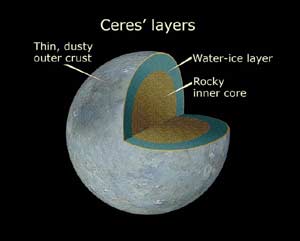 Earth seeded with life from Ceres? Joop Houtkooper from the University of Giessen made this suggestion at the International Society for the Study of the Origin of Life conference in Florence, Italy. Ceres is a dwarf planet, 960 km in diameter, located in the asteroid belt. It appears to have lots of water, and it could have avoided the sterilizing "late heavy" bombardment that Earth endured. Ceres is uphill from us in the sun's gravity well, with low surface gravity, so fragments of it could plausibly end up on Earth. The idea was taken seriously. Meanwhile, the Dawn space probe, launched by NASA in 2007, should arrive at Ceres in 2015.
Earth seeded with life from Ceres? Joop Houtkooper from the University of Giessen made this suggestion at the International Society for the Study of the Origin of Life conference in Florence, Italy. Ceres is a dwarf planet, 960 km in diameter, located in the asteroid belt. It appears to have lots of water, and it could have avoided the sterilizing "late heavy" bombardment that Earth endured. Ceres is uphill from us in the sun's gravity well, with low surface gravity, so fragments of it could plausibly end up on Earth. The idea was taken seriously. Meanwhile, the Dawn space probe, launched by NASA in 2007, should arrive at Ceres in 2015.
 Could Life on Earth Have Come From Ceres? by Lee Pullen, Astrobiology Magazine, 5 Mar; also SpaceDaily, 6 Mar 2009. Could Life on Earth Have Come From Ceres? by Lee Pullen, Astrobiology Magazine, 5 Mar; also SpaceDaily, 6 Mar 2009.
 Life on Ceres: Could the Dwarf Planet be the Root of Panspermia? by Ian O'Neill, Universe Today, 5 Mar 2009. Life on Ceres: Could the Dwarf Planet be the Root of Panspermia? by Ian O'Neill, Universe Today, 5 Mar 2009.
 Life on Europa, Other Moons, Other Planets? is a webpage with links to other related articles. Life on Europa, Other Moons, Other Planets? is a webpage with links to other related articles.
 Thanks, Larry Klaes and Google Alerts. Thanks, Larry Klaes and Google Alerts.
 8 March 2009 8 March 2009
HGT also turns out to be the rule rather than the exception in the third great domain of life, the eukaryotes. So comments science reporter Graham Lawton in New Scientist. Reviewing the challenge to the traditional "tree of life" that horizontal gene transfer presents, he affirms that HGT is already known to drive prokaryotic evolution. We think it also drives eukaryotic evolution, bringing the programs for new systems and features. Perhaps this understanding is not far off:
Other cases of HGT in multicellular organisms are coming in thick and fast. HGT has been documented in insects, fish and plants, and a few years ago a piece of snake DNA was found in cows. The most likely agents of this genetic shuffling are viruses, which constantly cut and paste DNA from one genome into another, often across great taxonomic distances. In fact, by some reckonings, 40 to 50 per cent of the human genome consists of DNA imported horizontally by viruses, some of which has taken on vital biological functions.
Lawton reports that Michael Rose, an evolutionary biologist at the University of California, Irvine, goes even further: The tree of life is being politely buried, we all know that. What's less accepted is that our whole fundamental view of biology needs to change.
 Graham Lawton, "Why Darwin was wrong about the tree of life" [preview], New Scientist, 21 Jan 2009. Graham Lawton, "Why Darwin was wrong about the tree of life" [preview], New Scientist, 21 Jan 2009.
 Viruses and Other Gene Transfer Mechanisms is the main related webpage Viruses and Other Gene Transfer Mechanisms is the main related webpage
[ What'sNEW about HGT What'sNEW about HGT  ] ]
 The Tree of Life is a related webpage. "This problem is resolved if evolution makes extensive use of genes that are transfered horizontally." The Tree of Life is a related webpage. "This problem is resolved if evolution makes extensive use of genes that are transfered horizontally."
 Thanks, Dr. Doron Goldberg. Thanks, Dr. Doron Goldberg.
 4 March 2009 4 March 2009
James Lovelock's newest book, The Vanishing Face of Gaia, was a joy to read, even as it soberly considers the future of our environment. Pulling no punches, he eschews the expression global warming in favor of something stronger, global heating. His prescriptions for avoiding the worst disasters are not easy to swallow. The list of topics covered is long, and his opinions on some, like nuclear and wind energy, may surprise you.

We are especially interested in his continuing development of the original Gaia theory. More than before, he now emphasizes the view that the planet is a living thing with needs which may not perfectly align with those of humans. He laments that Gaia cannot reproduce, and that there is only one example of her.
On this last issue we have another view: If life spreads by panspermia, perhaps every moon or planet is another testing place for gaian principles. This possibility opens new windows on questions like Why is Mars red? and Why is Titan's atmosphere dominated by nitrogen? Would Lovelock ever become interested? At 90 years old, planning to view Gaia from space, he has probably done enough.
In his writing Lovelock comes through as a generous and caring spirit. Since its inception, his Gaia theory has incited vigorous and sometimes rude opposition, yet Lovelock expresses no ill will. He even seems to enjoy the company of some opponents. To uphold so radical a theory in such a gentle manner is rare. Could we do that?
 James Lovelock, The Vanishing Face of Gaia: A Final Warning, ISBN:9780465015498, Basic Books, 13 Apr 2009. James Lovelock, The Vanishing Face of Gaia: A Final Warning, ISBN:9780465015498, Basic Books, 13 Apr 2009.
 The Vanishing Face of Gaia by James Lovelock, review by Bryan Lovell, Times Newspapers Ltd., 21 Feb 2009. The Vanishing Face of Gaia by James Lovelock, review by Bryan Lovell, Times Newspapers Ltd., 21 Feb 2009.
 Introduction... is a related webpage. "Here we endorse Lovelock's theory at its original strength." Introduction... is a related webpage. "Here we endorse Lovelock's theory at its original strength."
 Gaia is a related webpage. "...the existence of Gaian processes prior to the establishment of life on Earth." Gaia is a related webpage. "...the existence of Gaian processes prior to the establishment of life on Earth."
 Thanks for an advance copy, Cassie Dendurent Nelson, Perseus Books Group. Thanks for an advance copy, Cassie Dendurent Nelson, Perseus Books Group.
 Lee R. Kump, "A Second Opinion for Our Planet" [abstract], doi:10.1126/science.1175952, p 539-540 v 325, Science, 31 Jul 2009. Lee R. Kump, "A Second Opinion for Our Planet" [abstract], doi:10.1126/science.1175952, p 539-540 v 325, Science, 31 Jul 2009.
 3 March 2009 3 March 2009
For microbes, it appears that almost all of their major evolution took place before we have any record of them, way back in the dark mists of prehistory — University of Washington paleontologist and astrobiologist Roger Buick
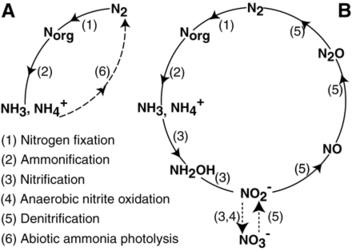
Hypothesized Nitrogen cycles before and during Mount McRae isotope excursion.
(A) Without oxygen, before 2.5 billion years ago. The broken line indicates abiotic processes.
(B) With oxygen, 2.5 billion years ago. The dotted line indicates plausible but unproven processes. |
Buick's team concluded that microbes capable of metabolizing oxygen went to work as soon as oxygen became available in the atmosphere. This is the best explanation for the pattern of isotope signatures found in the Mount McRae shale deposits created 2.5 billion years ago in the Pilbara region of northwest Australia. The isotopes indicate that denitrification — and therefore also nitrate formation requiring oxygen — were already under way "shortly before the main rise in O2.... Thus, an aerobic component to the N cycle was transiently active before the atmosphere became oxygen-rich after 2.45 Ga."
The genetic programs for aerobic metabolism would not be close variants of pre-existing programs for metabolism without oxygen. (For example, compare cycles B and A in the figure). Therefore, the darwinian process for composing the programs de novo — in an environment with no more than traces of oxygen — would be lengthy at best. But apparently, the programs were immediately ready for use when oxygen became available. It seems to us more likely that these genetic programs were already present in the biosphere, and were activated when oxygen was first released.
 Jessica Garvin et al., "Isotopic Evidence for an Aerobic Nitrogen Cycle in the Latest Archean" [abstract], doi:10.1126/science.1165675, p 1045-1048 v 323, Science, 20 Feb 2009. Jessica Garvin et al., "Isotopic Evidence for an Aerobic Nitrogen Cycle in the Latest Archean" [abstract], doi:10.1126/science.1165675, p 1045-1048 v 323, Science, 20 Feb 2009.
 Billions of years ago, microbes were key in developing modern nitrogen cycle, University of Washington News [also Newswise], 19 Feb 2009. Billions of years ago, microbes were key in developing modern nitrogen cycle, University of Washington News [also Newswise], 19 Feb 2009.
 Bacteria... is a related webpage. "Bacteria have the ability to colonize an unfriendly planet." Bacteria... is a related webpage. "Bacteria have the ability to colonize an unfriendly planet."
 Gaia is a related webpage. "Gaia makes much more sense if the stabilizing feedback loops were not blindly discovered, but were already available when the need for them arose." Gaia is a related webpage. "Gaia makes much more sense if the stabilizing feedback loops were not blindly discovered, but were already available when the need for them arose."
 Metazoan Genes Older Than Metazoa? is a related webpage. "Cosmic Ancestry requires that genes precede the phenotypic expression of themselves." Metazoan Genes Older Than Metazoa? is a related webpage. "Cosmic Ancestry requires that genes precede the phenotypic expression of themselves."
 1 March 2009 1 March 2009
Russia plans to send a variety of microbes and larger life on a round-trip to Phobos in October. The Phobos-Grunt mission also aims to return samples of the Martian moon to Earth for analysis.

 Earth Critters Hitch Ride to Martian Moon and Back, by Irene Klotz, Discovery News, 25 Feb 2009. Earth Critters Hitch Ride to Martian Moon and Back, by Irene Klotz, Discovery News, 25 Feb 2009.
 Sending Earth-Life to Phobos?, by Sean Welton, VisualAstronomy.com, 1 Mar 2009. Sending Earth-Life to Phobos?, by Sean Welton, VisualAstronomy.com, 1 Mar 2009.
 Russia Will Send Life to Phobos, by Ian O'Neill, Universe Today, 1 Mar 2009. Russia Will Send Life to Phobos, by Ian O'Neill, Universe Today, 1 Mar 2009.
 History of the Phobos Grunt project, by Anatoly Zak, russianspaceweb.com, 23 Jun 2008. History of the Phobos Grunt project, by Anatoly Zak, russianspaceweb.com, 23 Jun 2008.
 Life on Mars! is a related webpage. Life on Mars! is a related webpage.
 Thanks, National Public Radio, Rob Cooper and Google Alerts. Thanks, National Public Radio, Rob Cooper and Google Alerts.
 28 February 2009 28 February 2009
 We posit that these changes allow bacterial transcription factors to incorporate newly acquired genes into ancestral regulatory circuits and yet retain control of the core members of a regulon.
We posit that these changes allow bacterial transcription factors to incorporate newly acquired genes into ancestral regulatory circuits and yet retain control of the core members of a regulon. This conclusion comes from a pair of molecular microbiologists at Howard Hughes Medical Institute, Washington University School of Medicine, St. Louis, studying the action of prokaryotic regulatory mechanisms in evolution. In the theory promoted on this website, evolutionary innovations depend on the acquisition of new genetic programs by some form of gene transfer (HGT). For the evolution of prokaryotes, this principle has quietly become orthodoxy. Now a team at Wash U is exploring the details of one example of the process.
 J. Christian Perez and Eduardo A. Groisman, "Transcription factor function and promoter architecture govern the evolution of bacterial regulons" [Open Access abstract], doi:10.1073/pnas.0810343106, Proc. Natl. Acad. Sci. USA, online 27 Feb 2009. J. Christian Perez and Eduardo A. Groisman, "Transcription factor function and promoter architecture govern the evolution of bacterial regulons" [Open Access abstract], doi:10.1073/pnas.0810343106, Proc. Natl. Acad. Sci. USA, online 27 Feb 2009.
 Viruses and Other Gene Transfer Mechanisms is the main related webpage Viruses and Other Gene Transfer Mechanisms is the main related webpage
[ What'sNEW about HGT What'sNEW about HGT  ] ]
 27 February 2009 27 February 2009
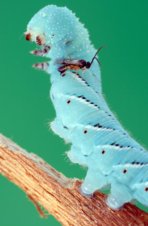 It is well documented that genes of viral origin are used by eukaryotes to ensure physiological functions.... This observation comes from a team led by entomologist Jean-Michel Drezen of the University of Tours in France. They recently showed that a virus infecting wasps millions of years ago installed genes that enable the wasps to paralyze caterpillars and lay their eggs inside them. The toxin that paralyzes the caterpillars consists of protein-encased, double-stranded DNA particles that were produced in the wasps' ovaries.
It is well documented that genes of viral origin are used by eukaryotes to ensure physiological functions.... This observation comes from a team led by entomologist Jean-Michel Drezen of the University of Tours in France. They recently showed that a virus infecting wasps millions of years ago installed genes that enable the wasps to paralyze caterpillars and lay their eggs inside them. The toxin that paralyzes the caterpillars consists of protein-encased, double-stranded DNA particles that were produced in the wasps' ovaries.
This example adds to a long list demonstrating that important genetic programs have been acquired by gene transfer (HGT). These examples sustain a prediction of cosmic ancestry — that genetic programs for features lacking in a species must be acquired by gene transfer. Among eukaryotes, viruses are the most effective and ubiquitous, but not the only, mechanism of horizontal gene transfer.
 Annie Bézier et al., "Polydnaviruses of Braconid Wasps Derive from an Ancestral Nudivirus" [abstract], doi:10.1126/science.1166788, p 926-930 v 323, Science, 13 Feb 2009. Annie Bézier et al., "Polydnaviruses of Braconid Wasps Derive from an Ancestral Nudivirus" [abstract], doi:10.1126/science.1166788, p 926-930 v 323, Science, 13 Feb 2009.
 Donald B. Stoltz and James B. Whitfield, "Making Nice with Viruses" [summary], doi:10.1126/science.1169808, p 884-885 v 323, Science, 13 Feb 2009. Donald B. Stoltz and James B. Whitfield, "Making Nice with Viruses" [summary], doi:10.1126/science.1169808, p 884-885 v 323, Science, 13 Feb 2009.
 Eric Espagne, Catherine Dupuy et al., "Genome Sequence of a Polydnavirus: Insights into Symbiotic Virus Evolution" [abstract], doi:10.1126/science.1103066, p 286-289 v 306, Science, 8 Oct 2004. Eric Espagne, Catherine Dupuy et al., "Genome Sequence of a Polydnavirus: Insights into Symbiotic Virus Evolution" [abstract], doi:10.1126/science.1103066, p 286-289 v 306, Science, 8 Oct 2004.
 Ancient Virus Gave Wasps Their Sting, by Rachel Zelkowitz, ScienceNOW Daily News, 12 Feb 2009. Ancient Virus Gave Wasps Their Sting, by Rachel Zelkowitz, ScienceNOW Daily News, 12 Feb 2009.
 Viruses and Other Gene Transfer Mechanisms is the main related webpage Viruses and Other Gene Transfer Mechanisms is the main related webpage
[ What'sNEW about HGT What'sNEW about HGT  ] ]
 Metazoan Genes Older Than Metazoa? is a webpage about genetic programs that seem to exist before they are needed. Metazoan Genes Older Than Metazoa? is a webpage about genetic programs that seem to exist before they are needed.
 22 February 2009 22 February 2009
 ...Living microbes could have survived both the launch and travel in the vacuum of space for periods long enough for them to have arrived intact on the surface of our planet — H. Jay Melosh, University of Arizona Regents' Professor of planetary sciences. Melosh (pictured) will deliver the Blitzer Award Lecture, "Are We All Martians? The Meteoritic Exchange of Life Between Planets," at 4 p.m. Wednesday, Feb. 25, in the Physics and Atmospheric Sciences building, University of Arizona, Tucson. In an interview he comments, Biological exchange between the planets of our solar system seem[s] not only possible, but inevitable.
...Living microbes could have survived both the launch and travel in the vacuum of space for periods long enough for them to have arrived intact on the surface of our planet — H. Jay Melosh, University of Arizona Regents' Professor of planetary sciences. Melosh (pictured) will deliver the Blitzer Award Lecture, "Are We All Martians? The Meteoritic Exchange of Life Between Planets," at 4 p.m. Wednesday, Feb. 25, in the Physics and Atmospheric Sciences building, University of Arizona, Tucson. In an interview he comments, Biological exchange between the planets of our solar system seem[s] not only possible, but inevitable.
 Are We All Martians?, by Lori Stiles, University of Arizona, 10 Feb 2009. Are We All Martians?, by Lori Stiles, University of Arizona, 10 Feb 2009.
 Life on Mars! is a related webpage. Life on Mars! is a related webpage.
 Thanks, Google Alerts. Thanks, Google Alerts.
 18 February 2009 18 February 2009
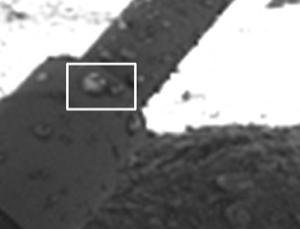 Liquid water on Phoenix Lander's leg? Images received soon after Phoenix touched down on Mars, 25 May 2008 showed liquid-like splotches that grew in size for a few weeks. They could have been salty water droplets that grew as they absorbed additional water vapor from Mars' atmosphere. If so, then liquid water can persist at Mars' surface, contrary to theoretical predictions. Phoenix team members will explain the case in a study to be presented in March at the Lunar and Planetary Science Conference in Houston TX.
Liquid water on Phoenix Lander's leg? Images received soon after Phoenix touched down on Mars, 25 May 2008 showed liquid-like splotches that grew in size for a few weeks. They could have been salty water droplets that grew as they absorbed additional water vapor from Mars' atmosphere. If so, then liquid water can persist at Mars' surface, contrary to theoretical predictions. Phoenix team members will explain the case in a study to be presented in March at the Lunar and Planetary Science Conference in Houston TX.
 First liquid water may have been spotted on Mars, by David Shiga, NewScientist.com, 18 Feb 2009. First liquid water may have been spotted on Mars, by David Shiga, NewScientist.com, 18 Feb 2009.
 40th Lunar and Planetary Science Conference, The Woodlands Waterway Marriott Hotel and Convention Center, The Woodlands TX, 23-27 Mar 2009. 40th Lunar and Planetary Science Conference, The Woodlands Waterway Marriott Hotel and Convention Center, The Woodlands TX, 23-27 Mar 2009.
 Life on Mars! is a related webpage. Life on Mars! is a related webpage.
 Thanks, Jerry Chancellor. Thanks, Jerry Chancellor.
 Liquid saltwater is likely present on Mars, new analysis shows, Physorg.com, 17 Mar 2009. Liquid saltwater is likely present on Mars, new analysis shows, Physorg.com, 17 Mar 2009.
 22 May 2009: You don't necessarily need to have a lot of water to have life.... 22 May 2009: You don't necessarily need to have a lot of water to have life....
 18 February 2009 18 February 2009
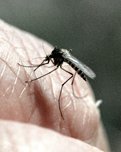 Mosquito survives in outer space. That's the headline of a web story from the Russian News and Information Agency Novosti. According to Anatoly Grigoryev, vice president of the Russian Academy of Sciences, after a mosquito was exposed on the exterior of the International Space Station for 18 months, "We brought him back to Earth. He is alive, and his feet are moving." Even we are sceptical. We will watch for corroboration.
Mosquito survives in outer space. That's the headline of a web story from the Russian News and Information Agency Novosti. According to Anatoly Grigoryev, vice president of the Russian Academy of Sciences, after a mosquito was exposed on the exterior of the International Space Station for 18 months, "We brought him back to Earth. He is alive, and his feet are moving." Even we are sceptical. We will watch for corroboration.
 Mosquito survives in outer space, by Alexander Peslyak, RIA Novosti, 18 Feb 2009. Mosquito survives in outer space, by Alexander Peslyak, RIA Novosti, 18 Feb 2009.
 Introduction: More than Panspermia is a related webpage. Introduction: More than Panspermia is a related webpage.
 Thanks, Google Alerts. Thanks, Google Alerts.
 31 January 2009 31 January 2009
 Titan's atmospheric methane requires a source not visible on the surface. Otherwise, its lakes of methane would go dry within a few million years. A team led by Dr. Elizabeth Turtle at the Johns Hopkins University Applied Physics Lab announced this conclusion Thursday in Geophysical Research Letters.
Titan's atmospheric methane requires a source not visible on the surface. Otherwise, its lakes of methane would go dry within a few million years. A team led by Dr. Elizabeth Turtle at the Johns Hopkins University Applied Physics Lab announced this conclusion Thursday in Geophysical Research Letters. Titan, the largest moon of Saturn, has lakes of methane much larger than Earth's Great Lakes, concentrated in the two polar regions. Recently NASA's Cassini orbiter has seen these grow, and has seen extensive cloud systems form seasonally. A methane rain apparently fills the lakes during the rainy season. Turtle says, "Our new map provides more coverage of Titan's poles, but even if all of the features we see there were filled with liquid methane, there's still not enough to sustain the atmosphere for more than 10 million years." The preferred explanation is that an underground reservoir supplies the missing methane. If so, we think this would have been originally produced my methanogenic bacteria, as on Earth. But how large would the reservoir need to be to sustain the atmospheric methane for, say, a billion years? Could methanogenic bacteria still be at work there?
 E. P. Turtle et al., "Cassini imaging of Titan's high-latitude lakes, clouds, and south-polar surface changes" [abstract], doi:10.1029/2008GL036186, v36, L02204, Geophys. Res. Lett., 29 Jan 2009. E. P. Turtle et al., "Cassini imaging of Titan's high-latitude lakes, clouds, and south-polar surface changes" [abstract], doi:10.1029/2008GL036186, v36, L02204, Geophys. Res. Lett., 29 Jan 2009.
 Cassini Finds Hydrocarbon Rains May Fill Titan Lakes, CICLOPS/Space Science Institute; also The Johns Hopkins University Applied Physics Laboratory, 29 Jan 2009. Cassini Finds Hydrocarbon Rains May Fill Titan Lakes, CICLOPS/Space Science Institute; also The Johns Hopkins University Applied Physics Laboratory, 29 Jan 2009.
 Titan's Methane Mystery, by Phil Berardelli, ScienceNOW Daily News, 30 Jan 2009. Titan's Methane Mystery, by Phil Berardelli, ScienceNOW Daily News, 30 Jan 2009.
 Methane rain fills Titan's lakes, by Dr. Emily Baldwin, Astronomy Now, 30 Jan 2009. Methane rain fills Titan's lakes, by Dr. Emily Baldwin, Astronomy Now, 30 Jan 2009.
 Life on Europa, Other Moons, Other Planets? is a webpage with links to other related articles. Life on Europa, Other Moons, Other Planets? is a webpage with links to other related articles.
 29 January 2009 29 January 2009
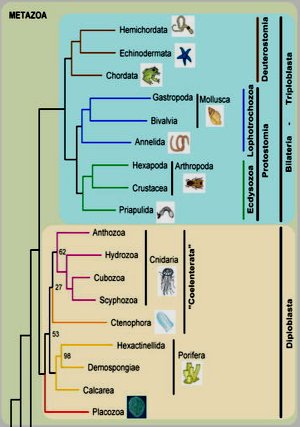 The placula already had all the genes necessary to make all the building blocks [of a nervous system], but it didn't have to make it because ecology didn't force it to do so. Zoologist Bernd Schierwater of the University of Veterinary Medicine Hannover in Germany makes this observation following a "total evidence" analysis of early metazoan evolution. His team used data from every relevant category in order to ascertain the most basal metazoan in the phylogeny of life. They decide that placozoa came first. Meanwhile, they pause to observe —
The placula already had all the genes necessary to make all the building blocks [of a nervous system], but it didn't have to make it because ecology didn't force it to do so. Zoologist Bernd Schierwater of the University of Veterinary Medicine Hannover in Germany makes this observation following a "total evidence" analysis of early metazoan evolution. His team used data from every relevant category in order to ascertain the most basal metazoan in the phylogeny of life. They decide that placozoa came first. Meanwhile, they pause to observe —
 The study identifies Placozoa as the most basal diploblast group and thus a living fossil genome that nicely demonstrates, not only that complex genetic tool kits arise before morphological complexity, but also that these kits may form similar morphological structures in parallel. The study identifies Placozoa as the most basal diploblast group and thus a living fossil genome that nicely demonstrates, not only that complex genetic tool kits arise before morphological complexity, but also that these kits may form similar morphological structures in parallel.
 The genome of the placozoan Trichoplax adhaerens indeed delivers some notable evidence that the genetic inventory may precede morphological manifestation of organs. For example, the placozoan genome harbors representatives of all major genes that are involved in neurogenesis in higher animals, whereas placozoans show not the slightest morphological hint of nerve or sensory cells. The genome of the placozoan Trichoplax adhaerens indeed delivers some notable evidence that the genetic inventory may precede morphological manifestation of organs. For example, the placozoan genome harbors representatives of all major genes that are involved in neurogenesis in higher animals, whereas placozoans show not the slightest morphological hint of nerve or sensory cells.
To us, these observations are the most interesting part. According to mainstream darwinism, natural selection is necessary for producing new genetic programs. Natural selection requires a lot of time. But these "complex genetic tool kits" apparently emerged whole, without any time or opportunity for natural selection to operate on the phenotypes they would/could produce. This finding should be mind-boggling to darwinists. Perhaps it could be considered an anomaly, if this were the only example. But it isn't. Similar examples crop up very often. We discussed another one yesterday.
In cosmic ancestry the genetic programs for major evolutionary steps always come first. A growing body of evidence is sustaining this order of events.
 Schierwater B, Eitel M, Jakob W, Osigus HJ, Hadrys H, et al., "Concatenated Analysis Sheds Light on Early Metazoan Evolution and Fuels a Modern 'Urmetazoon' Hypothesis" [abstract], doi:10.1371/journal.pbio.1000020, PLoS Biology v 7, n 1, e20, online 27 Jan 2009. Schierwater B, Eitel M, Jakob W, Osigus HJ, Hadrys H, et al., "Concatenated Analysis Sheds Light on Early Metazoan Evolution and Fuels a Modern 'Urmetazoon' Hypothesis" [abstract], doi:10.1371/journal.pbio.1000020, PLoS Biology v 7, n 1, e20, online 27 Jan 2009.
 Humans and sponges may share a slimy ancestor, by Asher Mullard, doi:10.1038/news.2009.55, Nature.com, online 26 Jan 2009. Humans and sponges may share a slimy ancestor, by Asher Mullard, doi:10.1038/news.2009.55, Nature.com, online 26 Jan 2009.
 ...Genomic complexity was present very early on.... — an earlier What'sNEW article about placozoans, 22 Aug 2008. ...Genomic complexity was present very early on.... — an earlier What'sNEW article about placozoans, 22 Aug 2008.
 Metazoan Genes Older Than Metazoa? is the related webpage with links to other findings of surprisingly old genetic programs. Metazoan Genes Older Than Metazoa? is the related webpage with links to other findings of surprisingly old genetic programs.
 Thanks, Stan Franklin and Bob Sweeney. Thanks, Stan Franklin and Bob Sweeney.
 28 January 2009 28 January 2009
Lignin has been found in marine algae. Lignin is an essential ingredient of wood, which enables land plants to support themselves. Aquatic plants contain no wood; water supports them. Botanist Patrick Martone comments:
 All land plants evolved from aquatic green algae and scientists have long believed that lignin evolved after plants took to land as a mechanical adaptation for stabilizing upright growth and transporting water from the root. Because red and green algae likely diverged more than a billion years ago, the discovery of lignin in red algae suggests that the basic machinery for producing lignin may have existed long before algae moved to land.
All land plants evolved from aquatic green algae and scientists have long believed that lignin evolved after plants took to land as a mechanical adaptation for stabilizing upright growth and transporting water from the root. Because red and green algae likely diverged more than a billion years ago, the discovery of lignin in red algae suggests that the basic machinery for producing lignin may have existed long before algae moved to land.
Why would genetic programs for lignin evolve before they were needed, without the pressure of natural selection? This is a mystery for darwinists. Alternatively, could lignin have evolved in red algae separately, after it diverged from green algae? Marine biologist Mark Denny of Stanford thinks not —
The pathways, enzymes and genes that go into making this stuff are pretty complicated, so to come up with all those separately would be really, really amazing. Anything is possible, but that would be one hell of a coincidence. In cosmic ancestry the genetic programs for major evolutionary steps always come first. Lignin is only the latest of many examples that affirm this order of events.
 Patrick T. Martone, José M. Estevez, Fachuang Lu et al., "Discovery of Lignin in Seaweed Reveals Convergent Evolution of Cell-Wall Architecture" [abstract], doi:10.1016/j.cub.2008.12.031, p 169-175 v 19, Current Biology, 22 Jan 2009. Patrick T. Martone, José M. Estevez, Fachuang Lu et al., "Discovery of Lignin in Seaweed Reveals Convergent Evolution of Cell-Wall Architecture" [abstract], doi:10.1016/j.cub.2008.12.031, p 169-175 v 19, Current Biology, 22 Jan 2009.
 Catherine Clabby, "A Tangled Tale of Plant Evolution" [html], doi:10.1511/2009.78.202, p 202 v 97, American Scientist, Mar-Apr 2009. Catherine Clabby, "A Tangled Tale of Plant Evolution" [html], doi:10.1511/2009.78.202, p 202 v 97, American Scientist, Mar-Apr 2009.
 Billion-year revision of plant evolution timeline may stem from discovery of lignin in seaweed, The University of British Columbia Public Affairs, 27 Jan 2009. Billion-year revision of plant evolution timeline may stem from discovery of lignin in seaweed, The University of British Columbia Public Affairs, 27 Jan 2009.
 Metazoan Genes Older Than Metazoa? is the related webpage with links to other findings of surprisingly old genetic programs. Metazoan Genes Older Than Metazoa? is the related webpage with links to other findings of surprisingly old genetic programs.
 Thanks, EurekAlert! and Jim Galasyn. Thanks, EurekAlert! and Jim Galasyn.
 19 January 2009 19 January 2009
Nonretroviral RNA viruses may have contributed more substantially and directly to the evolution of mammalian genomes than has been assumed so far, according to an international team of virologists. They observed that these viruses can install genes acquired from retroposons into mouse germ lines. Geneticists already knew that retroviruses could install genes acquired elsewhere into eukaryotic germlines, to be inherited. Nonretroviral RNA viruses apparently can, too.

 Markus B. Geuking et al., "Recombination of Retrotransposon and Exogenous RNA Virus Results in Nonretroviral cDNA Integration" [abstract], doi:10.1126/science.1167375, p 393-396 v 323, Science, 16 Jan 2009. Markus B. Geuking et al., "Recombination of Retrotransposon and Exogenous RNA Virus Results in Nonretroviral cDNA Integration" [abstract], doi:10.1126/science.1167375, p 393-396 v 323, Science, 16 Jan 2009.
 The integration of genes from a non retroviral RNA virus into the DNA of eukaryotic cells... is a related What'sNEW article, 23 Nov 1997. The integration of genes from a non retroviral RNA virus into the DNA of eukaryotic cells... is a related What'sNEW article, 23 Nov 1997.
 Viruses and Other Gene Transfer Mechanisms is the main related webpage Viruses and Other Gene Transfer Mechanisms is the main related webpage
[ What'sNEW about HGT What'sNEW about HGT  ] ]
 Thanks for this and many other alerts, Stan Franklin (pictured). Thanks for this and many other alerts, Stan Franklin (pictured).
 16 January 2009 16 January 2009
 Methane plumes on Mars may come from life. This idea has become more credible following comprehensive analysis from a team led by astronomer Michael Mumma of NASA's Goddard Space Flight Center. In certain hotspots on Mars, "The methane averages 33 parts per billion in the summer but essentially disappears afterward." The methane could be recently produced, in which case it would almost certainly come from life. But it might be older, and only recently released, "when summer warming breaks an icy seal on the surface." Even in that case, life could have originally produced the methane, as it does on Earth. But finally, all methane production, even if nonbiological, requires liquid water. Liquid water on Mars, by itself, is a powerful argument in favor of life there.
Methane plumes on Mars may come from life. This idea has become more credible following comprehensive analysis from a team led by astronomer Michael Mumma of NASA's Goddard Space Flight Center. In certain hotspots on Mars, "The methane averages 33 parts per billion in the summer but essentially disappears afterward." The methane could be recently produced, in which case it would almost certainly come from life. But it might be older, and only recently released, "when summer warming breaks an icy seal on the surface." Even in that case, life could have originally produced the methane, as it does on Earth. But finally, all methane production, even if nonbiological, requires liquid water. Liquid water on Mars, by itself, is a powerful argument in favor of life there.
"Of special interest are the deep bio-communities that utilize H2 (produced by radiolysis of water) as an energy source (reducing CO2 to CH4). These communities thrive at 2-3 km depth in the Witwatersrand Basin of South Africa and have been isolated from the surface (and photosynthesis) for millions of years. It might be possible for analogous biota to survive for eons below the cryosphere boundary on Mars, where water is again liquid, radiolysis can supply energy, and CO2 can provide carbon."
 Michael J. Mumma et al., "Strong Release of Methane on Mars in Northern Summer 2003" [abstract], doi:10.1126/science.1165243, Science, online 15 Jan 2009. Michael J. Mumma et al., "Strong Release of Methane on Mars in Northern Summer 2003" [abstract], doi:10.1126/science.1165243, Science, online 15 Jan 2009.
 Mars Has Methane, But Life? by Richard A. Kerr, ScienceNOW Daily News, 15 Jan 2009. Mars Has Methane, But Life? by Richard A. Kerr, ScienceNOW Daily News, 15 Jan 2009.
 Martian Methane Belch: From Rocks or Microbes?, The New York Times, 16 Jan 2009. Martian Methane Belch: From Rocks or Microbes?, The New York Times, 16 Jan 2009.
 Nasa reveals life on Mars, The Sun, London, 15 Jan 2009. Nasa reveals life on Mars, The Sun, London, 15 Jan 2009.
 On Mars, plumes of methane hundreds of kilometres across... — a What'sNEW article about this research, 25 Oct 2008. On Mars, plumes of methane hundreds of kilometres across... — a What'sNEW article about this research, 25 Oct 2008.
 Life on Mars! is a related webpage. Search for "methane". Life on Mars! is a related webpage. Search for "methane".
 Thanks, Ron McGhee. Thanks, Ron McGhee.
 10 January 2009 10 January 2009
 Methane has been detected in the plume of Enceladus and may be biological in origin. So say astrobiologistst studying data from this small icy moon of Saturn. The observations come from NASA's Cassini orbiter, now on an extension of its original four-year mission. Cassini has observed geysers of water containing organic compounds erupting from Enceladus's south polar terrain (see artist's concept). "Tiger stripe" fractures and anomalous hot spots are also there. These phenomena have led NASA to suggest that an ice-covered ocean on Enceladus may contain life, and even that panspermia may have delivered it!
Methane has been detected in the plume of Enceladus and may be biological in origin. So say astrobiologistst studying data from this small icy moon of Saturn. The observations come from NASA's Cassini orbiter, now on an extension of its original four-year mission. Cassini has observed geysers of water containing organic compounds erupting from Enceladus's south polar terrain (see artist's concept). "Tiger stripe" fractures and anomalous hot spots are also there. These phenomena have led NASA to suggest that an ice-covered ocean on Enceladus may contain life, and even that panspermia may have delivered it!
 Christopher P. McKay et al., "The Possible Origin and Persistence of Life on Enceladus and Detection of Biomarkers in the Plume" [abstract], doi:10.1089/ast.2008.0265, p 909-919 v 8, Astrobiology, 1 Oct 2008. Christopher P. McKay et al., "The Possible Origin and Persistence of Life on Enceladus and Detection of Biomarkers in the Plume" [abstract], doi:10.1089/ast.2008.0265, p 909-919 v 8, Astrobiology, 1 Oct 2008.
 Source of Geysers on Saturn's Moon May Be Underground Water, by Zenaida Gonzalez Kotala, University of Central Florida, 26 Nov 2008. Source of Geysers on Saturn's Moon May Be Underground Water, by Zenaida Gonzalez Kotala, University of Central Florida, 26 Nov 2008.
 Enceladus shoots supersonic jets of water, by Ashley Yeager, doi:10.1038/news.2008.1254, Nature.com, 26 Nov 2008. Enceladus shoots supersonic jets of water, by Ashley Yeager, doi:10.1038/news.2008.1254, Nature.com, 26 Nov 2008.
 Cassini Passes Through Ice Plumes of Enceladus, Astronomy Picture of the Day, 13 Oct 2008. Cassini Passes Through Ice Plumes of Enceladus, Astronomy Picture of the Day, 13 Oct 2008.
 Life on Europa, Other Moons, Other Planets? is a related webpage. Life on Europa, Other Moons, Other Planets? is a related webpage.
 Thanks, Google Alerts. Thanks, Google Alerts.
 7 January 2009 7 January 2009
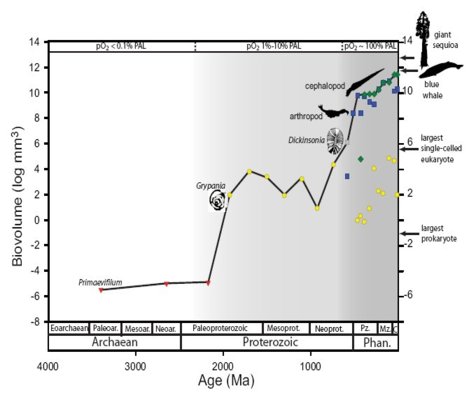
"Approximately 3/4 of the 16-orders-of-magnitude increase in maximum size occurred in 2 discrete episodes. The first size jump required the evolution of the eukaryotic cell, and the second required eukaryotic multicellularity. The size increases appear to have occurred when ambient oxygen ...reached sufficient concentrations for clades to realize preexisting evolutionary potential, highlighting the long-term dependence of macroevolutionary pattern on both biological potential and environmental opportunity." [Blue shading illustrates oxygen concentration.] © The National Academy of Sciences, 2009 |
Latent evolutionary potential was realized soon after environmental limitations were removed. This suggestion comes from an interdisciplinary team studying the fossil record of life's largest species. For each era before 2,500 million years ago, and each period thereafter, they ascertained the body volumes of the largest prokaryotes and, when they appeared, single-celled eukaryotes, metazoans, and vascular plants.From the earliest fossilized prokaryotes to the extinct dinosaurs and today's trees and whales, the maximum size of living things has increased by 16 orders of magnitude. This size did not increase gradually, as darwinism would predict. Rather, most of the increase occurred "during 2 geologically brief intervals," when maximum body volumes grew roughly a million times larger, each time. The researchers observe, "These size steps coincide with, or slightly postdate, increases in the concentration of atmospheric oxygen, suggesting latent evolutionary potential was realized soon after environmental limitations were removed."
Under darwinism, complex new genetic programs, such as those encoding eukaryotic cells and multicellularity, must be blindly, gradually composed by long trial and error. But apparently, long trial and error was not necessary for these two big evolutionary steps. This surprise induces the research team to introduce a new concept, "latent evolutionary potential," into darwinian theory.
This concept is already a fundamental, well-defined principle of cosmic ancestry. Latent evolutionary potential is the content of pre-existing genetic programs, ready to be expressed when conditions are right. Thus, the new research sustains a prediction of cosmic ancestry.
 Jonathan L. Payne et al., "Two-phase increase in the maximum size of life over 3.5 billion years reflects biological innovation and environmental opportunity" [Open Access abstract], doi:10.1073/pnas.0806314106, p 24-27 v 106, Proc. Natl. Acad. Sci. USA, 6 Jan 2009. Jonathan L. Payne et al., "Two-phase increase in the maximum size of life over 3.5 billion years reflects biological innovation and environmental opportunity" [Open Access abstract], doi:10.1073/pnas.0806314106, p 24-27 v 106, Proc. Natl. Acad. Sci. USA, 6 Jan 2009.
 Life got bigger in two, million-fold leaps, scientists say, by Louis Bergeron, Stanford University (also Physorg.com), 22 Dec 2008. Life got bigger in two, million-fold leaps, scientists say, by Louis Bergeron, Stanford University (also Physorg.com), 22 Dec 2008.
 Metazoan Genes Older Than Metazoa? is a related webpage. Metazoan Genes Older Than Metazoa? is a related webpage.
 Gaia is a related webpage. Gaia is a related webpage.
 Neo-Darwinism: The Current Paradigm is a related webpage with a section on Punctuated Equilibrium. Neo-Darwinism: The Current Paradigm is a related webpage with a section on Punctuated Equilibrium.
 Thanks, Stan Franklin. Thanks, Stan Franklin.
|

 On the other hand, life as we know it creates only left-handed amino acids. And when life dies out, this chirality slowly degrades away. For some amino acids, this degradation can take billions of years. Could the surprising excess of left-handed amino acids in all six meteorites have been left by ancient microbial life on their parent bodies?
On the other hand, life as we know it creates only left-handed amino acids. And when life dies out, this chirality slowly degrades away. For some amino acids, this degradation can take billions of years. Could the surprising excess of left-handed amino acids in all six meteorites have been left by ancient microbial life on their parent bodies? The samples were gathered from a balloon flown from the National Balloon Facility in Hyderabad, operated by the Tata Institute of Fundamental Research. They were analysed at the Center for Cellular and Molecular Biology, Hyderabad as well as the National Center for Cell Science, Pune. Jayant Narlikar was Principal Investigator, with support from U.R. Rao and P.M. Bhargava. Ravi Manchanda managed the balloon facility, C.B.S. Dutt oversaw the payload, and S. Shivaji and Yogesh Shouche directed the biological analysis.
The samples were gathered from a balloon flown from the National Balloon Facility in Hyderabad, operated by the Tata Institute of Fundamental Research. They were analysed at the Center for Cellular and Molecular Biology, Hyderabad as well as the National Center for Cell Science, Pune. Jayant Narlikar was Principal Investigator, with support from U.R. Rao and P.M. Bhargava. Ravi Manchanda managed the balloon facility, C.B.S. Dutt oversaw the payload, and S. Shivaji and Yogesh Shouche directed the biological analysis.
 ...Symbiogenesis, interspecific fusions (hybridogenesis, gene transfers of various types, karyotypic fissioning, and other forms of acquisition of 'foreign genomes' or epigenesis) are more important than the slow gradual accumulation of mutation or sexual mergers —
Lynn Margulis, Distinguished University Professor in the Department of Geosciences at the University of Massachusetts, Amherst.
...Symbiogenesis, interspecific fusions (hybridogenesis, gene transfers of various types, karyotypic fissioning, and other forms of acquisition of 'foreign genomes' or epigenesis) are more important than the slow gradual accumulation of mutation or sexual mergers —
Lynn Margulis, Distinguished University Professor in the Department of Geosciences at the University of Massachusetts, Amherst. In this example, the source for the human gene is vertical inheritance from lower mammals. Its "origin" remains unexplained. This report simply says, "The IRG gene family exists as multiple copies in most mammalian species...."
In this example, the source for the human gene is vertical inheritance from lower mammals. Its "origin" remains unexplained. This report simply says, "The IRG gene family exists as multiple copies in most mammalian species...."
 Earth seeded with life from Ceres? Joop Houtkooper from the University of Giessen made this suggestion at the International Society for the Study of the Origin of Life conference in Florence, Italy. Ceres is a dwarf planet, 960 km in diameter, located in the asteroid belt. It appears to have lots of water, and it could have avoided the sterilizing "late heavy" bombardment that Earth endured. Ceres is uphill from us in the sun's gravity well, with low surface gravity, so fragments of it could plausibly end up on Earth. The idea was taken seriously. Meanwhile, the Dawn space probe, launched by NASA in 2007, should arrive at Ceres in 2015.
Earth seeded with life from Ceres? Joop Houtkooper from the University of Giessen made this suggestion at the International Society for the Study of the Origin of Life conference in Florence, Italy. Ceres is a dwarf planet, 960 km in diameter, located in the asteroid belt. It appears to have lots of water, and it could have avoided the sterilizing "late heavy" bombardment that Earth endured. Ceres is uphill from us in the sun's gravity well, with low surface gravity, so fragments of it could plausibly end up on Earth. The idea was taken seriously. Meanwhile, the Dawn space probe, launched by NASA in 2007, should arrive at Ceres in 2015.


 We posit that these changes allow bacterial transcription factors to incorporate newly acquired genes into ancestral regulatory circuits and yet retain control of the core members of a regulon.
We posit that these changes allow bacterial transcription factors to incorporate newly acquired genes into ancestral regulatory circuits and yet retain control of the core members of a regulon. It is well documented that genes of viral origin are used by eukaryotes to ensure physiological functions.... This observation comes from a team led by entomologist Jean-Michel Drezen of the University of Tours in France. They recently showed that a virus infecting wasps millions of years ago installed genes that enable the wasps to paralyze caterpillars and lay their eggs inside them. The toxin that paralyzes the caterpillars consists of protein-encased, double-stranded DNA particles that were produced in the wasps' ovaries.
It is well documented that genes of viral origin are used by eukaryotes to ensure physiological functions.... This observation comes from a team led by entomologist Jean-Michel Drezen of the University of Tours in France. They recently showed that a virus infecting wasps millions of years ago installed genes that enable the wasps to paralyze caterpillars and lay their eggs inside them. The toxin that paralyzes the caterpillars consists of protein-encased, double-stranded DNA particles that were produced in the wasps' ovaries.
 ...Living microbes could have survived both the launch and travel in the vacuum of space for periods long enough for them to have arrived intact on the surface of our planet — H. Jay Melosh, University of Arizona Regents' Professor of planetary sciences. Melosh (pictured) will deliver the Blitzer Award Lecture, "Are We All Martians? The Meteoritic Exchange of Life Between Planets," at 4 p.m. Wednesday, Feb. 25, in the Physics and Atmospheric Sciences building, University of Arizona, Tucson. In an interview he comments, Biological exchange between the planets of our solar system seem[s] not only possible, but inevitable.
...Living microbes could have survived both the launch and travel in the vacuum of space for periods long enough for them to have arrived intact on the surface of our planet — H. Jay Melosh, University of Arizona Regents' Professor of planetary sciences. Melosh (pictured) will deliver the Blitzer Award Lecture, "Are We All Martians? The Meteoritic Exchange of Life Between Planets," at 4 p.m. Wednesday, Feb. 25, in the Physics and Atmospheric Sciences building, University of Arizona, Tucson. In an interview he comments, Biological exchange between the planets of our solar system seem[s] not only possible, but inevitable. Liquid water on Phoenix Lander's leg? Images received soon after Phoenix touched down on Mars, 25 May 2008 showed liquid-like splotches that grew in size for a few weeks. They could have been salty water droplets that grew as they absorbed additional water vapor from Mars' atmosphere. If so, then liquid water can persist at Mars' surface, contrary to theoretical predictions. Phoenix team members will explain the case in a study to be presented in March at the Lunar and Planetary Science Conference in Houston TX.
Liquid water on Phoenix Lander's leg? Images received soon after Phoenix touched down on Mars, 25 May 2008 showed liquid-like splotches that grew in size for a few weeks. They could have been salty water droplets that grew as they absorbed additional water vapor from Mars' atmosphere. If so, then liquid water can persist at Mars' surface, contrary to theoretical predictions. Phoenix team members will explain the case in a study to be presented in March at the Lunar and Planetary Science Conference in Houston TX. Mosquito survives in outer space. That's the headline of a web story from the Russian News and Information Agency Novosti. According to Anatoly Grigoryev, vice president of the Russian Academy of Sciences, after a mosquito was exposed on the exterior of the International Space Station for 18 months, "We brought him back to Earth. He is alive, and his feet are moving." Even we are sceptical. We will watch for corroboration.
Mosquito survives in outer space. That's the headline of a web story from the Russian News and Information Agency Novosti. According to Anatoly Grigoryev, vice president of the Russian Academy of Sciences, after a mosquito was exposed on the exterior of the International Space Station for 18 months, "We brought him back to Earth. He is alive, and his feet are moving." Even we are sceptical. We will watch for corroboration. Titan's atmospheric methane requires a source not visible on the surface. Otherwise, its lakes of methane would go dry within a few million years. A team led by Dr. Elizabeth Turtle at the Johns Hopkins University Applied Physics Lab announced this conclusion Thursday in Geophysical Research Letters.
Titan's atmospheric methane requires a source not visible on the surface. Otherwise, its lakes of methane would go dry within a few million years. A team led by Dr. Elizabeth Turtle at the Johns Hopkins University Applied Physics Lab announced this conclusion Thursday in Geophysical Research Letters. The placula already had all the genes necessary to make all the building blocks [of a nervous system], but it didn't have to make it because ecology didn't force it to do so. Zoologist Bernd Schierwater of the University of Veterinary Medicine Hannover in Germany makes this observation following a "total evidence" analysis of early metazoan evolution. His team used data from every relevant category in order to ascertain the most basal metazoan in the phylogeny of life. They decide that placozoa came first. Meanwhile, they pause to observe —
The placula already had all the genes necessary to make all the building blocks [of a nervous system], but it didn't have to make it because ecology didn't force it to do so. Zoologist Bernd Schierwater of the University of Veterinary Medicine Hannover in Germany makes this observation following a "total evidence" analysis of early metazoan evolution. His team used data from every relevant category in order to ascertain the most basal metazoan in the phylogeny of life. They decide that placozoa came first. Meanwhile, they pause to observe — All land plants evolved from aquatic green algae and scientists have long believed that lignin evolved after plants took to land as a mechanical adaptation for stabilizing upright growth and transporting water from the root. Because red and green algae likely diverged more than a billion years ago, the discovery of lignin in red algae suggests that the basic machinery for producing lignin may have existed long before algae moved to land.
All land plants evolved from aquatic green algae and scientists have long believed that lignin evolved after plants took to land as a mechanical adaptation for stabilizing upright growth and transporting water from the root. Because red and green algae likely diverged more than a billion years ago, the discovery of lignin in red algae suggests that the basic machinery for producing lignin may have existed long before algae moved to land.

 Methane plumes on Mars may come from life. This idea has become more credible following comprehensive analysis from a team led by astronomer Michael Mumma of NASA's Goddard Space Flight Center. In certain hotspots on Mars, "The methane averages 33 parts per billion in the summer but essentially disappears afterward." The methane could be recently produced, in which case it would almost certainly come from life. But it might be older, and only recently released, "when summer warming breaks an icy seal on the surface." Even in that case, life could have originally produced the methane, as it does on Earth. But finally, all methane production, even if nonbiological, requires liquid water. Liquid water on Mars, by itself, is a powerful argument in favor of life there.
Methane plumes on Mars may come from life. This idea has become more credible following comprehensive analysis from a team led by astronomer Michael Mumma of NASA's Goddard Space Flight Center. In certain hotspots on Mars, "The methane averages 33 parts per billion in the summer but essentially disappears afterward." The methane could be recently produced, in which case it would almost certainly come from life. But it might be older, and only recently released, "when summer warming breaks an icy seal on the surface." Even in that case, life could have originally produced the methane, as it does on Earth. But finally, all methane production, even if nonbiological, requires liquid water. Liquid water on Mars, by itself, is a powerful argument in favor of life there.
 Methane has been detected in the plume of Enceladus and may be biological in origin. So say astrobiologistst studying data from this small icy moon of Saturn. The observations come from NASA's Cassini orbiter, now on an extension of its original four-year mission. Cassini has observed geysers of water containing organic compounds erupting from Enceladus's south polar terrain (see artist's concept). "Tiger stripe" fractures and anomalous hot spots are also there. These phenomena have led NASA to suggest that an ice-covered ocean on Enceladus may contain life, and even that panspermia may have delivered it!
Methane has been detected in the plume of Enceladus and may be biological in origin. So say astrobiologistst studying data from this small icy moon of Saturn. The observations come from NASA's Cassini orbiter, now on an extension of its original four-year mission. Cassini has observed geysers of water containing organic compounds erupting from Enceladus's south polar terrain (see artist's concept). "Tiger stripe" fractures and anomalous hot spots are also there. These phenomena have led NASA to suggest that an ice-covered ocean on Enceladus may contain life, and even that panspermia may have delivered it!